Haochen Tan
Pangu DeepDiver: Adaptive Search Intensity Scaling via Open-Web Reinforcement Learning
May 30, 2025Abstract:Information seeking demands iterative evidence gathering and reflective reasoning, yet large language models (LLMs) still struggle with it in open-web question answering. Existing methods rely on static prompting rules or training with Wikipedia-based corpora and retrieval environments, limiting adaptability to the real-world web environment where ambiguity, conflicting evidence, and noise are prevalent. These constrained training settings hinder LLMs from learning to dynamically decide when and where to search, and how to adjust search depth and frequency based on informational demands. We define this missing capacity as Search Intensity Scaling (SIS)--the emergent skill to intensify search efforts under ambiguous or conflicting conditions, rather than settling on overconfident, under-verification answers. To study SIS, we introduce WebPuzzle, the first dataset designed to foster information-seeking behavior in open-world internet environments. WebPuzzle consists of 24K training instances and 275 test questions spanning both wiki-based and open-web queries. Building on this dataset, we propose DeepDiver, a Reinforcement Learning (RL) framework that promotes SIS by encouraging adaptive search policies through exploration under a real-world open-web environment. Experimental results show that Pangu-7B-Reasoner empowered by DeepDiver achieve performance on real-web tasks comparable to the 671B-parameter DeepSeek-R1. We detail DeepDiver's training curriculum from cold-start supervised fine-tuning to a carefully designed RL phase, and present that its capability of SIS generalizes from closed-form QA to open-ended tasks such as long-form writing. Our contributions advance adaptive information seeking in LLMs and provide a valuable benchmark and dataset for future research.
TIME: A Multi-level Benchmark for Temporal Reasoning of LLMs in Real-World Scenarios
May 19, 2025Abstract:Temporal reasoning is pivotal for Large Language Models (LLMs) to comprehend the real world. However, existing works neglect the real-world challenges for temporal reasoning: (1) intensive temporal information, (2) fast-changing event dynamics, and (3) complex temporal dependencies in social interactions. To bridge this gap, we propose a multi-level benchmark TIME, designed for temporal reasoning in real-world scenarios. TIME consists of 38,522 QA pairs, covering 3 levels with 11 fine-grained sub-tasks. This benchmark encompasses 3 sub-datasets reflecting different real-world challenges: TIME-Wiki, TIME-News, and TIME-Dial. We conduct extensive experiments on reasoning models and non-reasoning models. And we conducted an in-depth analysis of temporal reasoning performance across diverse real-world scenarios and tasks, and summarized the impact of test-time scaling on temporal reasoning capabilities. Additionally, we release TIME-Lite, a human-annotated subset to foster future research and standardized evaluation in temporal reasoning. The code is available at https://github.com/sylvain-wei/TIME , and the dataset is available at https://huggingface.co/datasets/SylvainWei/TIME .
MR-BEN: A Comprehensive Meta-Reasoning Benchmark for Large Language Models
Jun 20, 2024
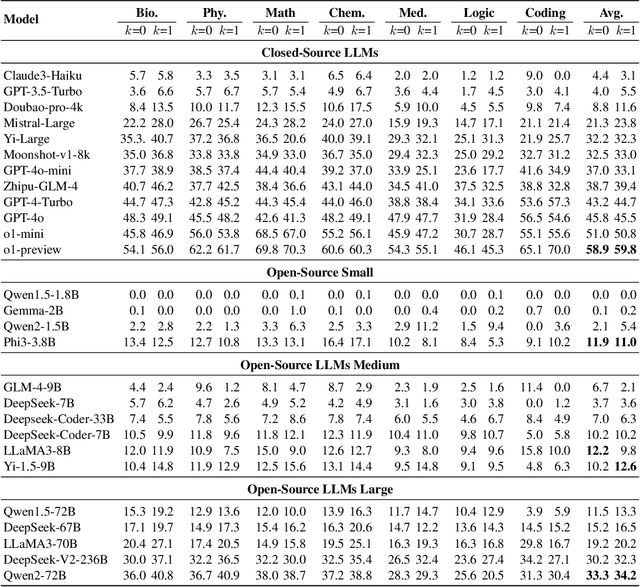
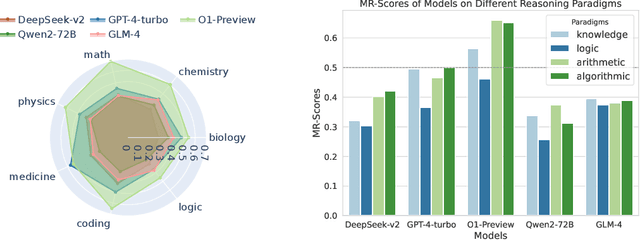

Abstract:Large language models (LLMs) have shown increasing capability in problem-solving and decision-making, largely based on the step-by-step chain-of-thought reasoning processes. However, it has been increasingly challenging to evaluate the reasoning capability of LLMs. Concretely, existing outcome-based benchmarks begin to saturate and become less sufficient to monitor the progress. To this end, we present a process-based benchmark MR-BEN that demands a meta reasoning skill, where LMs are asked to locate and analyse potential errors in automatically generated reasoning steps. MR-BEN is a comprehensive benchmark comprising 5,975 questions collected from human experts, covering various subjects such as physics, chemistry, logic, coding, and more. Through our designed metrics for assessing meta-reasoning on this benchmark, we identify interesting limitations and weaknesses of current LLMs (open-source and closed-source models). For example, open-source models are seemingly comparable to GPT-4 on outcome-based benchmarks, but they lag far behind on our benchmark, revealing the underlying reasoning capability gap between them. Our dataset and codes are available on https://randolph-zeng.github.io/Mr-Ben.github.io/.
MHPP: Exploring the Capabilities and Limitations of Language Models Beyond Basic Code Generation
May 19, 2024Abstract:Recent advancements in large language models (LLMs) have greatly improved code generation, specifically at the function level. For instance, GPT-4 has achieved an 88.4% pass rate on HumanEval. However, this draws into question the adequacy of existing benchmarks in thoroughly assessing function-level code generation capabilities. Our study analyzed two common benchmarks, HumanEval and MBPP, and found that these might not thoroughly evaluate LLMs' code generation capacities due to limitations in quality, difficulty, and granularity. To resolve this, we introduce the Mostly Hard Python Problems (MHPP) dataset, consisting of 140 unique human-curated problems. By focusing on the combination of natural language and code reasoning, MHPP gauges LLMs' abilities to comprehend specifications and restrictions, engage in multi-step reasoning, and apply coding knowledge effectively. Initial evaluations of 22 LLMs using MHPP showed many high-performing models on HumanEval failed to achieve similar success on MHPP. Moreover, MHPP highlighted various previously undiscovered limitations within various LLMs, leading us to believe that it could pave the way for a better understanding of LLMs' capabilities and limitations. Dataset and code are available at https://github.com/SparksofAGI/MHPP.
PROXYQA: An Alternative Framework for Evaluating Long-Form Text Generation with Large Language Models
Jan 26, 2024Abstract:Large Language Models (LLMs) have exhibited remarkable success in long-form context comprehension tasks. However, their capacity to generate long contents, such as reports and articles, remains insufficiently explored. Current benchmarks do not adequately assess LLMs' ability to produce informative and comprehensive content, necessitating a more rigorous evaluation approach. In this study, we introduce \textsc{ProxyQA}, a framework for evaluating long-form text generation, comprising in-depth human-curated \textit{meta-questions} spanning various domains. Each meta-question contains corresponding \textit{proxy-questions} with annotated answers. LLMs are prompted to generate extensive content in response to these meta-questions. Utilizing an evaluator and incorporating generated content as background context, \textsc{ProxyQA} evaluates the quality of generated content based on the evaluator's performance in answering the \textit{proxy-questions}. We examine multiple LLMs, emphasizing \textsc{ProxyQA}'s demanding nature as a high-quality assessment tool. Human evaluation demonstrates that evaluating through \textit{proxy-questions} is a highly self-consistent and human-criteria-correlated validation method. The dataset and leaderboard will be available at \url{https://github.com/Namco0816/ProxyQA}.
VCSUM: A Versatile Chinese Meeting Summarization Dataset
May 15, 2023Abstract:Compared to news and chat summarization, the development of meeting summarization is hugely decelerated by the limited data. To this end, we introduce a versatile Chinese meeting summarization dataset, dubbed VCSum, consisting of 239 real-life meetings, with a total duration of over 230 hours. We claim our dataset is versatile because we provide the annotations of topic segmentation, headlines, segmentation summaries, overall meeting summaries, and salient sentences for each meeting transcript. As such, the dataset can adapt to various summarization tasks or methods, including segmentation-based summarization, multi-granularity summarization and retrieval-then-generate summarization. Our analysis confirms the effectiveness and robustness of VCSum. We also provide a set of benchmark models regarding different downstream summarization tasks on VCSum to facilitate further research. The dataset and code will be released at https://github.com/hahahawu/VCSum.
Self-Supervised Sentence Compression for Meeting Summarization
May 13, 2023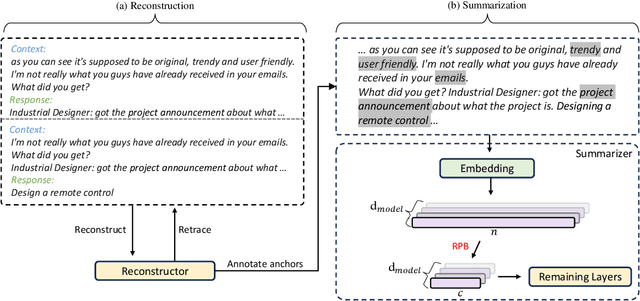
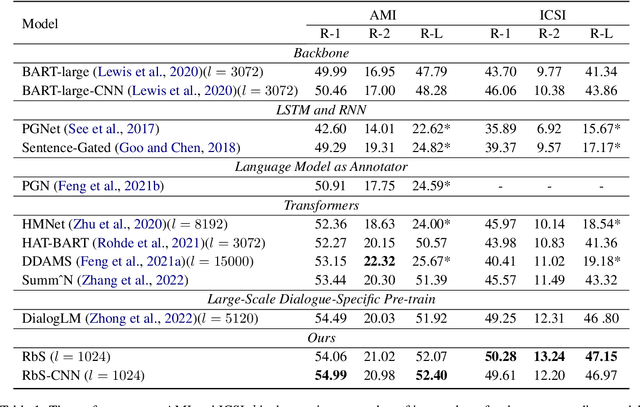
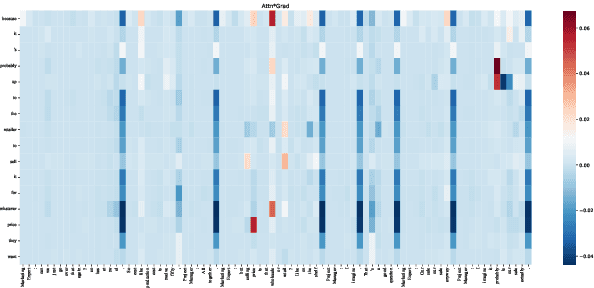
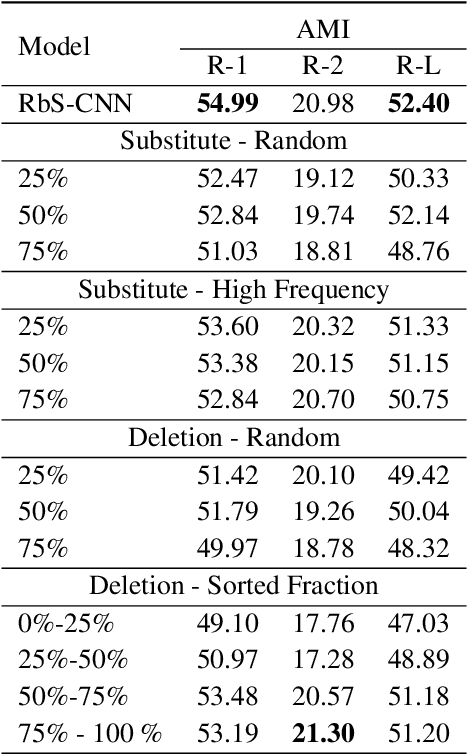
Abstract:The conventional summarization model often fails to capture critical information in meeting transcripts, as meeting corpus usually involves multiple parties with lengthy conversations and is stuffed with redundant and trivial content. To tackle this problem, we present SVB, an effective and efficient framework for meeting summarization that `compress' the redundancy while preserving important content via three processes: sliding-window dialogue restoration and \textbf{S}coring, channel-wise importance score \textbf{V}oting, and relative positional \textbf{B}ucketing. Specifically, under the self-supervised paradigm, the sliding-window scoring aims to rate the importance of each token from multiple views. Then these ratings are aggregated by channel-wise voting. Tokens with high ratings will be regarded as salient information and labeled as \textit{anchors}. Finally, to tailor the lengthy input to an acceptable length for the language model, the relative positional bucketing algorithm is performed to retain the anchors while compressing other irrelevant contents in different granularities. Without large-scale pre-training or expert-grade annotating tools, our proposed method outperforms previous state-of-the-art approaches. A vast amount of evaluations and analyses are conducted to prove the effectiveness of our method.
Towards Versatile and Efficient Visual Knowledge Injection into Pre-trained Language Models with Cross-Modal Adapters
May 12, 2023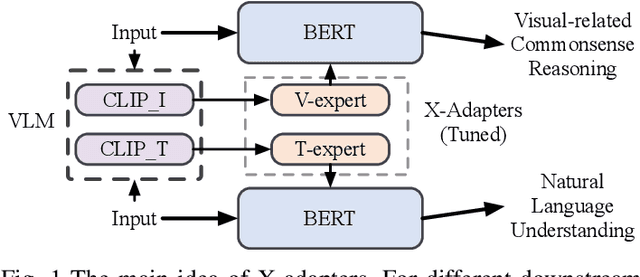

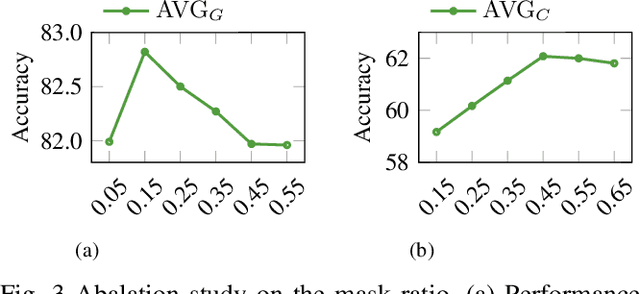
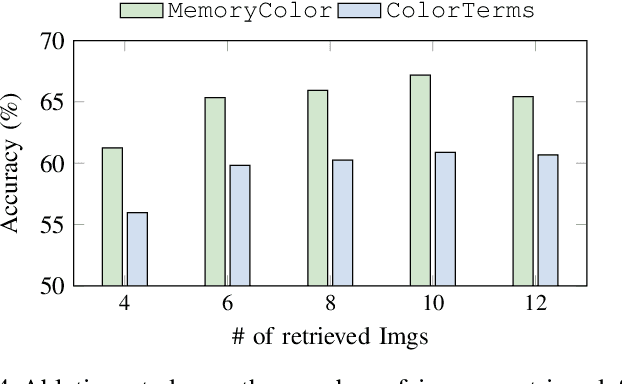
Abstract:Humans learn language via multi-modal knowledge. However, due to the text-only pre-training scheme, most existing pre-trained language models (PLMs) are hindered from the multi-modal information. To inject visual knowledge into PLMs, existing methods incorporate either the text or image encoder of vision-language models (VLMs) to encode the visual information and update all the original parameters of PLMs for knowledge fusion. In this paper, we propose a new plug-and-play module, X-adapter, to flexibly leverage the aligned visual and textual knowledge learned in pre-trained VLMs and efficiently inject them into PLMs. Specifically, we insert X-adapters into PLMs, and only the added parameters are updated during adaptation. To fully exploit the potential in VLMs, X-adapters consist of two sub-modules, V-expert and T-expert, to fuse VLMs' image and text representations, respectively. We can opt for activating different sub-modules depending on the downstream tasks. Experimental results show that our method can significantly improve the performance on object-color reasoning and natural language understanding (NLU) tasks compared with PLM baselines.
Learning Locality and Isotropy in Dialogue Modeling
May 29, 2022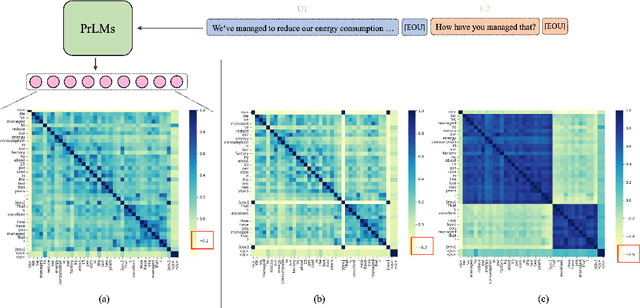
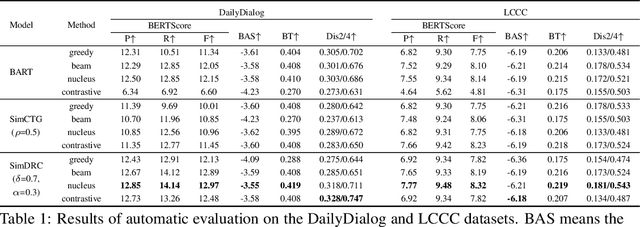
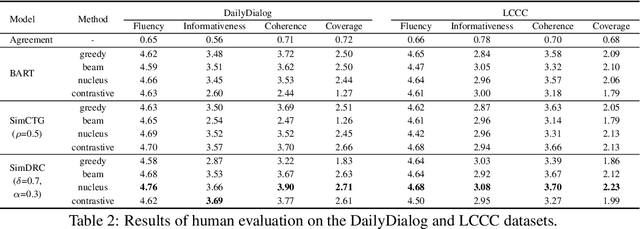
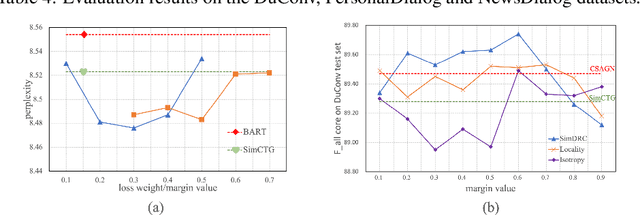
Abstract:Existing dialogue modeling methods have achieved promising performance on various dialogue tasks with the aid of Transformer and the large-scale pre-trained language models. However, some recent studies revealed that the context representations produced by these methods suffer the problem of anisotropy. In this paper, we find that the generated representations are also not conversational, losing the conversation structure information during the context modeling stage. To this end, we identify two properties in dialogue modeling, i.e., locality and isotropy, and present a simple method for dialogue representation calibration, namely SimDRC, to build isotropic and conversational feature spaces. Experimental results show that our approach significantly outperforms the current state-of-the-art models on three dialogue tasks across the automatic and human evaluation metrics. More in-depth analyses further confirm the effectiveness of our proposed approach.
Zero-shot Cross-lingual Conversational Semantic Role Labeling
Apr 11, 2022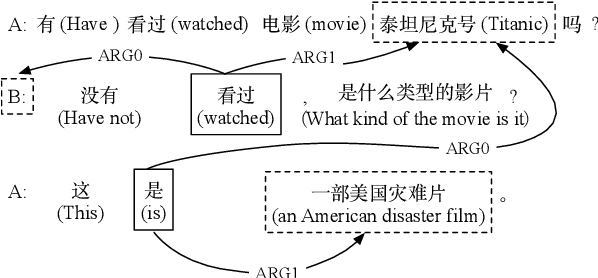

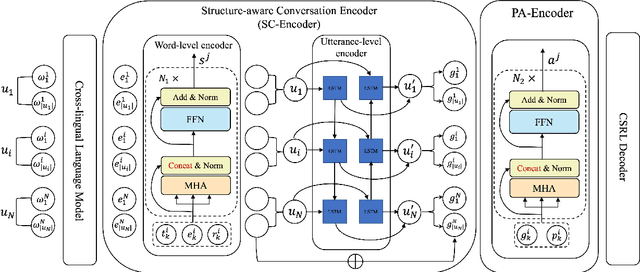
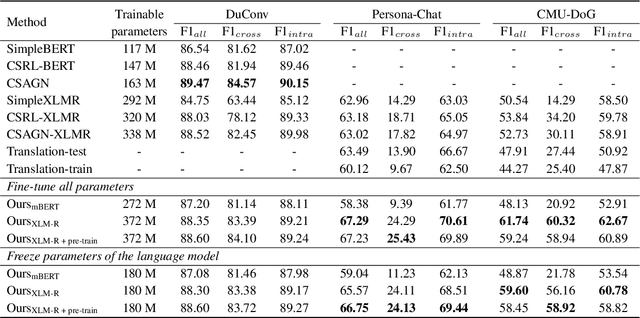
Abstract:While conversational semantic role labeling (CSRL) has shown its usefulness on Chinese conversational tasks, it is still under-explored in non-Chinese languages due to the lack of multilingual CSRL annotations for the parser training. To avoid expensive data collection and error-propagation of translation-based methods, we present a simple but effective approach to perform zero-shot cross-lingual CSRL. Our model implicitly learns language-agnostic, conversational structure-aware and semantically rich representations with the hierarchical encoders and elaborately designed pre-training objectives. Experimental results show that our model outperforms all baselines by large margins on two newly collected English CSRL test sets. More importantly, we confirm the usefulness of CSRL to non-Chinese conversational tasks such as the question-in-context rewriting task in English and the multi-turn dialogue response generation tasks in English, German and Japanese by incorporating the CSRL information into the downstream conversation-based models. We believe this finding is significant and will facilitate the research of non-Chinese dialogue tasks which suffer the problems of ellipsis and anaphora.
 Add to Chrome
Add to Chrome Add to Firefox
Add to Firefox Add to Edge
Add to Edge